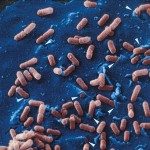Lien vers Pubmed [PMID] – 15383620
J. Cell. Sci. 2004 Oct;117(Pt 21):5097-106
Rickettsia conorii, the causative agent of Mediterranean spotted fever, is able to attach to and invade a variety of cell types both in vitro and in vivo. Although previous studies show that entry of R. conorii into non-phagocytic cells relies on actin polymerization, little else is known about the molecular details governing Rickettsia-host cell interactions and actin rearrangements. We determined that R. conorii recruits the Arp2/3 complex to the site of entry foci and that expression of an Arp 2/3 binding derivative of the WASP-family member, Scar, inhibited bacterial entry into Vero cells, establishing that Arp2/3 is an active component of this process. Using transient transfection with plasmids expressing dominant negative versions of small GTPases, we showed that Cdc42, but not Rac1 is involved in R. conorii invasion into Vero cells. Using pharmacological approaches, we show that this invasion is dependent on phosphoinositide (PI) 3-kinase and on protein tyrosine kinase (PTK) activities, in particular Src-family kinases. C-Src and its downstream target, p80/85 cortactin, colocalize at entry sites early in the infection process. R. conorii internalization correlated with the tyrosine phosphorylation of several other host proteins, including focal adhesion kinase (FAK), within minutes of R. conorii infection. Our results reveal that R. conorii entry into nonphagocytic cells is dependent on the Arp2/3 complex and that the interplay of pathways involving Cdc42, PI 3-kinase, c-Src, cortactin and tyrosine-phosphorylated proteins regulates Arp2/3 activation leading to the localized actin rearrangements observed during bacterial entry. This is the first report that documents the mechanism of entry of a rickettsial species into mammalian cells.

